Asus Transformer Pad Infinity Review
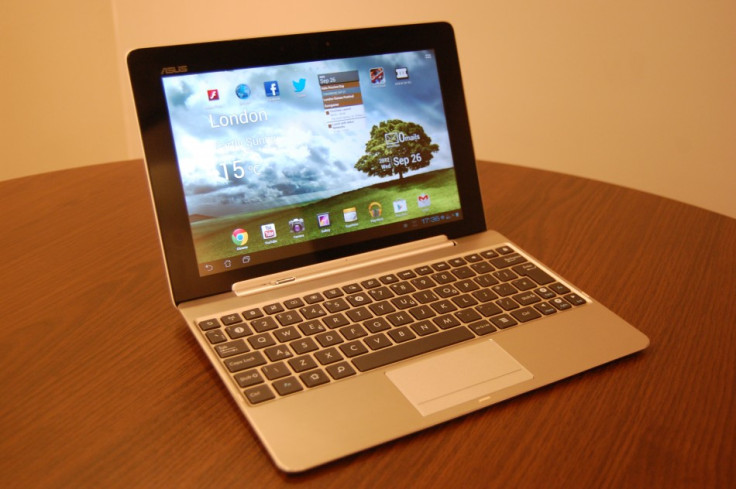
Key Features
- 10.1in screen with 1920 x 1200 resolution (224ppi)
- Nvidia Tegra 3, quad-core 1.6GHz processor with 1GB RAM
- 8 megapixel camera with 1080p HD video
- Android 4.0 (Ice Cream Sandwich)
- Dock with keyboard and trackpad
- Price as reviewed: £599 [dock included; 64GB]
Introduction
The Asus Transformer Pad Infinity is not an easy device to review. As with any other tablet/laptop hybrid, the Infinity Pad is a tablet that can be docked into a keyboard, turning it into a small laptop.
We hesitate to liken these devices to the the near-extinct netbook class, because with a quad-core 1.6GHz processor and HD screen, devices like the Infinity Pad are far more powerful than netbooks ever were.
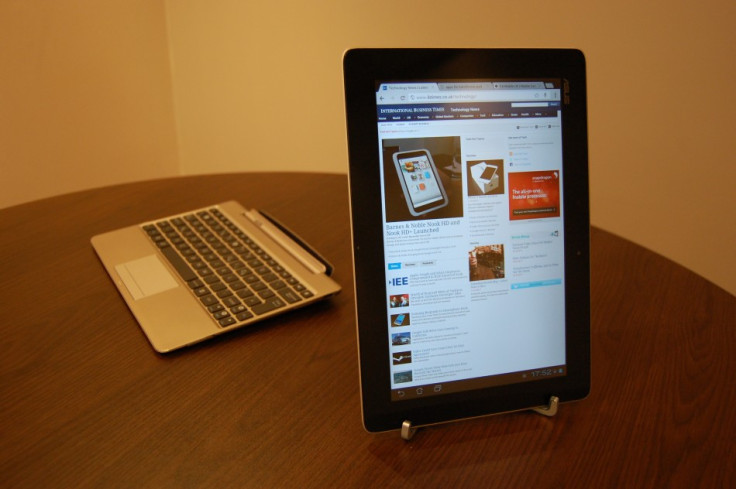
What we have here then is two devices in one. A 10.1in Android tablet with an incredibly powerful quad-core processor and 64GB of storage, and an equally powerful touch screen laptop with great battery life - because there are cells in the tablet as well as the keyboard.
The Asus Infinity certainly promises to deliver all the benefits of a small laptop - not quite an Ultrabook rival though, it's fairly chunky - as well as a tablet, but can it replace both and be bought by someone who doesn't want a conventional laptop? Let's find out.
Asus Transformer Pad Infinity: Design and Feel
Despite the Infinity's compact size, it's certainly not a lightweight. Weighing in at 598g the Infinity is fairly weighty, thanks to the all metal and glass construction, but it's still lighter than the new iPad. Connect the keyboard dock, however, and the weight gets close to 1kg.

Compared to the Transformer Pad 300, it's clear to see which is the more expensive model. The brushed aluminium and cold-to-the-touch finish of the Infinity feel much more premium than the cheaper 300, and the keyboard is much-improved too.
Docking the tablet into the keyboard is as simple as pushing them together and there is the dock connector and two posts to help you guide the screen into place.
We found you have to push the tablet quite firmly into the dock for it to lock into place, and even after the lock switch had clicked we found the tablet hadn't always been secured fully, but sliding the lock switch manually ensured the tablet was set in place.
To remove, simply flick the lock switch with your finger and lift the tablet out.
Because the tablet contains a lot more gubbins than your average laptop screen, the Asus Infinity is somewhat top-heavy, and while this feels strange at first, the keyboard is still heavy enough to keep itself grounded. It's fine when working at the desk, but balance the Asus on your lap on the train and be ready for it to topple over backwards.
Rather than resting flat on your desk, the keyboard is raised at the back when you open the screen, creating a more comfortable typing angle.
The keyboard dock has a full-size SD card slot - great for photographers - and one regular USB port on the right, and Asus's proprietary charging port on the left - and that's the same type of port that the tablet uses to charge and sync, too.

As for the tablet, there is a micro HDMI port for sending video and photos to your television or PC monitor and a 3.5mm headphone jack.
The power/screen lock button is in the top left corner, a volume rocker on the top right edge and finally a microSD card slot on the left.
On the whole, the Infinity feels well made and the metal finish gives off a premium image to back up the steep £599 retail price, but we noticed that the screen flexes quite easily when you're holding the device as a tablet.
It's not a major concern, but makes it feel like pressing a little too hard could cause serious damage to the LCD display.
Also while holding the tablet we found it to warm up quickly while not doing anything too demanding - but thankfully the temperature didn't rise to uncomfortable levels while gaming, as the new iPad is known to do.
Asus Transformer Pad Infinity: Hardware and Connectivity
The Transformer Pad Infinity is powered by Nvidia Tegra 3 chip featuring a 1.6GHz quad-core processor with 1GB of RAM (the faster DDR3 variety) and you can buy the Transformer with either 32GB or 64GB of storage. As we said above this can be increased with the SD slot in the keyboard and the microSD slot in the tablet.
As with the Asus Transformer Pad 300, the Infinity is typical of most Android tablets when it comes to connectivity. There's no microUSB port on the tablet itself, with Asus using a proprietary connector instead, while the dock makes do with just a single full-size USB 2.0 port.
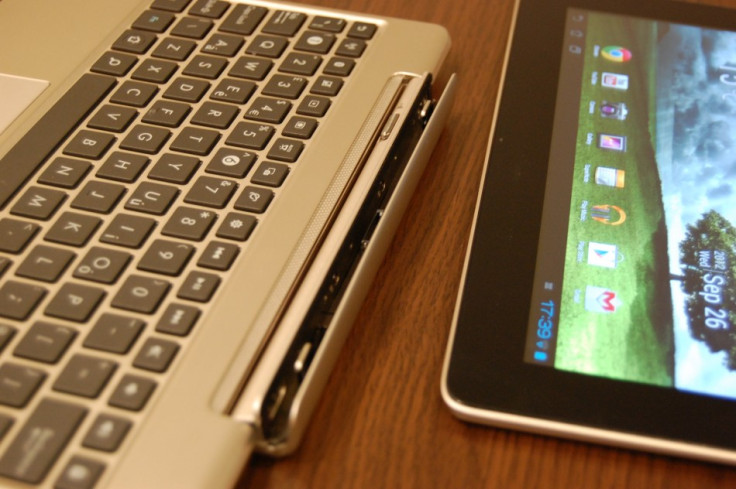
For charging and syncing Asus forces you to use its own bespoke plug, so you better make sure that you don't lose the cable and charger that it comes with.
Inside, the Asus Infinity has Wi-Fi 802.11 b/g/n, Bluetooth 3.0 with A2DP for streaming music to wireless speakers and headphones, an accelerometer, gyroscope and a compass for use with the maps app.
Above the Gorilla Glass-covered screen there is a front-facing 2 megapixel camera and around the back there's an 8 megapixel camera with autofocus, geo-tagging and an LED flash.
Asus Transformer Pad Infinity: Screen
Stepping up from the Transformer Pad 300, the Infinity gets a high definition 10.1in screen with a resolution of 1,920 x 1,200, producing a pixel density of 224 pixels per inch, just 40 below the Retina screen of the third-generation iPad. It also uses the same IPS display technology as the iPad 3, for superior viewing angles.
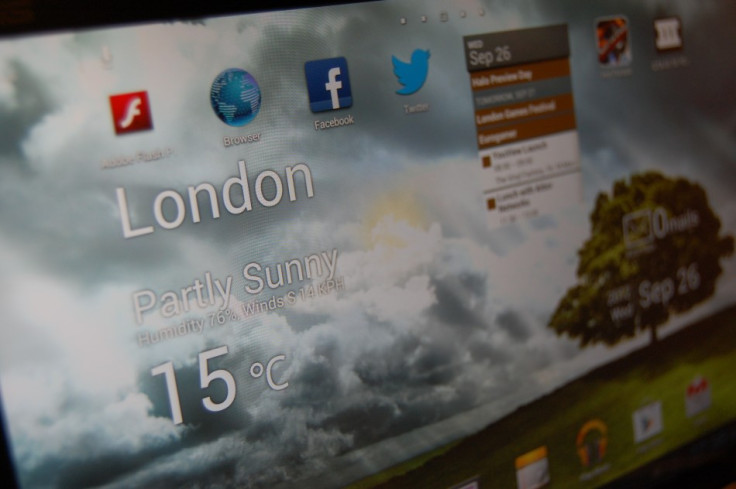
What this means in the real world is a screen that is mighty impressive. Individual pixels are impossible to make out and thanks to an optional Super IPS+ mode the display is incredibly bright, fending off glare from office lights and even sunlight.
The 16:9 aspect ratio is perfect when used as a laptop, but feels slightly odd as a tablet. We're used to the more square iPad and in comparison the Asus feels too long and narrow for general use, although for reading long articles online it is useful.
During our time with the Transformer Pad Infinity we found the screen to be excellent. Bright, crisp and responsive to touch - in fact, we'd say it's every bit as good as the new iPad's screen, and that's as high as compliments for tablet screens go.
Asus Transformer Pad Infinity: Cameras
Asus has given the Transformer Pad Infinity an 8 megapixel camera with LED flash and autofocus on the back, and a 2 megapixel camera on the front.
On paper at least, the rear camera is better than the 5 megapixel camera on the third generation iPad, but we've always wondered why manufacturers insist on installing high quality cameras on the back of tablets, when most smartphones are up to the job without making you look daft holding a tablet up in the air.

As with most Android devices, the Infinity gets a wide range of options and settings built into the camera app. Using a dial on the right side of the screen settings such as white balance, flash control and exposure can be adjusted, and there are nine different scene modes to choose from.
The Asus can shoot images at three, five or eight megapixels, as well as video at 480p, 720p or 1080p, and there's also a panoramic shooting option, which takes photos as you move the tablet from left to right before stitching them all together.
There's tap-to-focus, but pinch-to-zoom is missing so instead there is a semi-circular dial to swipe across with your thumb to zoom in and out.
Asus Transformer Pad Infinity: Keyboard
The keyboard of the Infinity represents a marked improvement over the older and cheaper Transformer Pad 300. The keys all have a decent amount of travel, provide good tactile feedback, and although they are smaller than your average laptop keys, typing quickly and accurately doesn't take much practice.
Asus has crammed a fully-featured keyboard into the Infinity dock, which means there are dedicated number keys, a wide range of function keys and everything else you would expect, but the compromise here is that you're never far away from accidentally turning the Wi-Fi off (just above the 1 key), or locking the system (above Backspace).
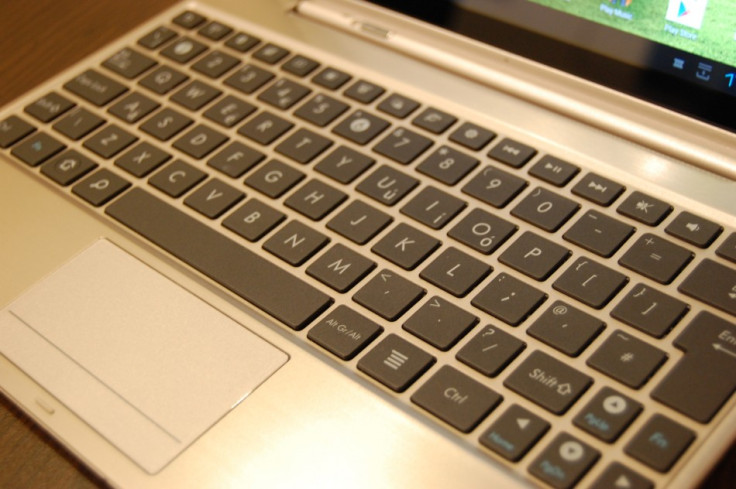
The trackpad is small compared to conventional laptops, but it's responsive and fast - almost too fast at times, which takes some getting used to - and clicking can be done by tapping the pad or physically clicking on the lower quarter.
Added to this, the lower right corner can be designated to work as a right click or a back button.
There's also smooth and responsive two-finger scrolling, but as before the sensitivity and speed of the trackpad takes some getting used to, and just the tiniest movements are needed to scroll through your Twitter feed.
There's no pinch-to-zoom here, but you can of course reach out and touch the screen if you need to zoom in - a motion that becomes second nature surprisingly quickly.
Asus Transformer Pad Infinity: Operating System
The Asus Infinity runs Android 4.0.4 (Ice Cream Sandwich), but an upgrade to 4.1 (Jelly Bean) is due any day now, with an Asus spokesperson telling us that it will arrive in the UK from 28 September.
Nevertheless, our review unit was running Ice Cream Sandwich and Asus has, in our opinion, made the right choice of altering the Android system very little from how Google intended it to be.
The Home screen - one of five - displays Asus's own location-based weather app by default along with the time, date and a widget attached to your email inbox, all sat on top of a custom wallpaper.
Ever-present at the foot of the display is the Android taskbar with Back, Home and Multitask buttons on the left, and the time, battery life and incoming notifications on the right.
We'd like this taskbar to hide while we watch video or play games - it could also reappear with the touch of a key - but it's small and not too intrusive.
Asus Transformer Pad Infinity: Performance and Battery Life
The Infinity tablet itself has a 6,757mAh battery that Asus claims is good for six hours of use, and the keyboard dock houses its own 5,270 mAh battery to increase that time by around 80 percent.
Once both tablet and dock are fully charged, it is the dock that starts to lose charge first, so the tablet will always be at 100 percent until the keyboard dies.
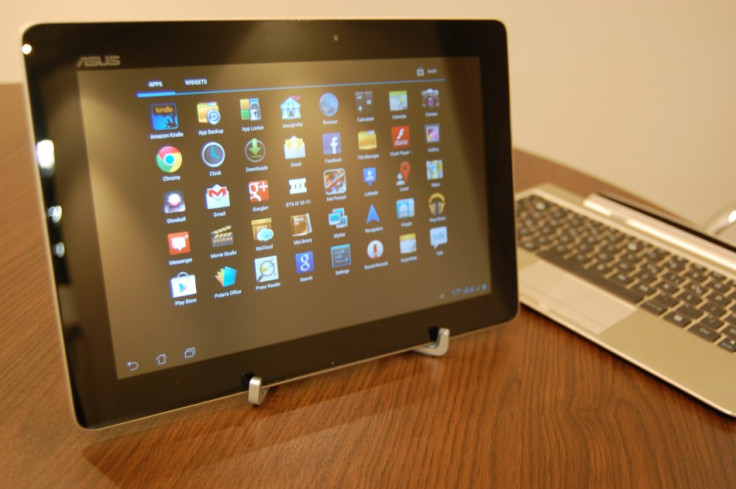
This means that the tablet is more likely to be charged when you need it without the dock, and when returned it will begin charging from whatever power the keyboard has left right away.
Remaining charge of both parts, along with an icon to show when the dock is charging the tablet, is shown in the lower right corner of the screen, along with the time and Wi-Fi signal.
In testing we found the Infinity to live up to Asus's claims, and with the keyboard attached the device lasted an entire working day of between eight and nine hours, with enough battery left to be used on the train home, too. If you need a tablet or small laptop that lasts all day, the Infinity should be very high on your list of options.
As you would expect from a quad-core Nvidia processor, the Asus Transformer Pad Infinity is no slouch, and shrugs off just about anything you have to throw at it.
HD video, intense 3D games, web browsing and multitasking are all completed with ease, making us confident that buying the tablet now would be a worthwhile investment, as it is unlikely to be outperformed by its rivals in the near future - especially considering the update to Jelly Bean.
Asus Transformer Pad Infinity: Verdict
If iOS isn't for you then the Asus Transformer Pad Infinity is quite possibly the best Android tablet on sale today, better even that Samsung's Galaxy range. It has 1.6GHz quad-core processing power, plenty of storage - with the option to add more - and the additional keyboard dock is far from a gimmick, offering extended battery life, connectivity, and turning a great tablet into a usable laptop replacement.
Whether we could live with the Infinity instead of a laptop altogether remains to be seen, but we're sure some casual computer users could make that a reality.
Our only complaints are that the keyboard sometimes feels cramped, with important function buttons set too close to commonly used keys, and the trackpad isn't as good as a full-size laptop.
Otherwise, the screen is excellent and is just as good as the iPad 3 - although the 16:9 ratio isn't for everyone - and with an update to Jelly Bean due any day, there's no reason to worry about the Infinity becoming out-of-date any time soon.
The best Android tablet on sale today? We think so.
Scores:
- Overall: 9/10
- Design: 9/10
- Screen: 9/10
- Keyboard: 8/10
- Connectivity: 8/10
- Value: 8/10
The Good:
- Excellent screen
- Very good battery life
- Great performance
The Bad:
- Heavy
- Keyboard feels cramped
- Expensive
© Copyright IBTimes 2025. All rights reserved.






















